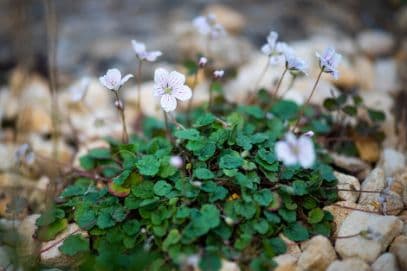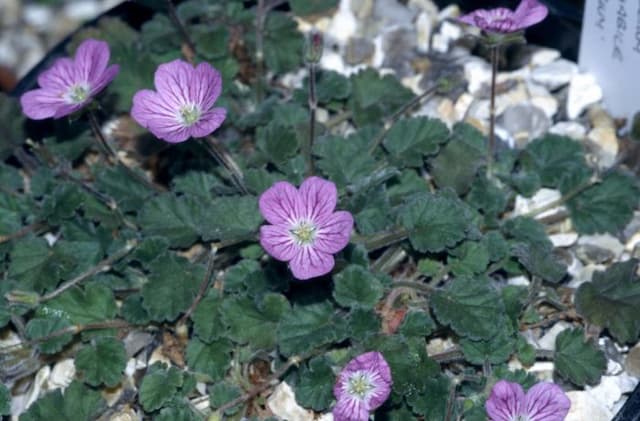Spanish Eyes Storksbill Erodium 'Spanish Eyes'

ABOUT
The Erodium 'Spanish Eyes' is a charming plant known for its decorative and delicate appearance. Its leaves are feathery and finely cut, presenting a soft, lacy texture that adds a lightness to the foliage. The standout feature of this variety is its flowers. They typically showcase a beautiful blend of colors, with petals that boast a warm, creamy base transitioning into pink or coral at the tips. The center of each bloom is often punctuated by deeper purple or burgundy markings, which can look like intricate veining giving the flowers a detailed and eye-catching appearance. The contrast of these colors gives the plant a lively, cheerful aspect, making it a popular choice for gardeners looking to add a splash of color to their floral arrangements. The overall impression of the Erodium 'Spanish Eyes' is one of relaxed charm and natural beauty, with its airy leaves and richly hued flowers creating a delightful spectacle in any garden setting.
About this plant
 Names
NamesFamily
Geraniaceae.
Synonyms
Spanish Eyes Storksbill, Spanish Eyes Erodium, Spanish Eyes Heron's Bill.
Common names
Erodium 'Spanish Eyes'
 Toxicity
ToxicityTo humans
Erodium 'Spanish Eyes' is not known to be toxic to humans. However, as with any plant, individual sensitivities can vary, and it is generally advisable not to ingest plants that are not specifically grown for consumption. In the absence of widespread reports of toxicity, though, no significant symptoms of poisoning or consequences are expected from ingesting parts of this plant.
To pets
Erodium 'Spanish Eyes' is not widely reported to be toxic to pets. This means that it is generally considered safe for dogs, cats, and other domestic animals. However, some animals might have individual reactions or sensitivities. If a pet ingested a substantial amount of the plant and is showing signs of distress, it is best to consult a veterinarian. In the absence of specific reports of poisoning, no defined symptoms or consequences are typically anticipated.
 Characteristics
CharacteristicsLife cycle
Annuals
Foliage type
Evergreen
Color of leaves
Green
Flower color
Pink
Height
1 foot (30 cm)
Spread
1 foot (30 cm)
Plant type
Herb
Hardiness zones
7
Native area
Mediterranean
Benefits
 General Benefits
General Benefits- Attracts pollinators: Spanish Eyes provides nectar and pollen for bees and other beneficial insects.
- Drought tolerance: Once established, Spanish Eyes is quite tolerant of dry conditions, making it a low-water garden choice.
- Easy to grow: It is known for being easy to care for and can thrive in a range of soil types and conditions.
- Aesthetic appeal: The delicate, fern-like foliage and pink to purple flowers add charm to garden beds, borders, and containers.
- Continuous blooming: It offers long flowering seasons, often from spring to fall, providing consistent color in the landscape.
- Compact growth: Its compact habit makes Spanish Eyes suitable for small gardens or spaces, and it does well in rock gardens or as ground cover.
- Deer resistance: It is typically resistant to deer, making it a good option for gardens in areas with deer populations.
 Medical Properties
Medical PropertiesThis plant is not used for medical purposes.
 Air-purifying Qualities
Air-purifying QualitiesThis plant is not specifically known for air purifying qualities.
 Other Uses
Other Uses- Erodium 'Spanish Eyes', or commonly known as storksbill, can be used as a low-growing groundcover in fairy gardens for a whimsical, miniature landscape effect.
- Storksbill's unique fern-like foliage can be used to add textural contrast in mixed succulent plantings or dish gardens.
- The plant can be cultivated in hanging baskets where its flowers can cascade over the edges, providing a delicate, airy display.
- Storksbill's seed pods resemble a stork's bill, and they can be used in educational settings to demonstrate plant adaptation and seed dispersal mechanisms to students.
- The dried seed pods of storksbill can be incorporated into rustic or naturalistic floral arrangements.
- Storksbill can be utilized as a living mulch to cover bare soil in garden beds, helping to reduce weed growth and conserve soil moisture.
- Photographers might use storksbill as a subject for macro photography to capture the intricate details of its flowers and foliage.
- Storksbill can be planted between stepping stones or pavers in a garden path, offering a burst of color and softening hard landscaping elements.
- The flowers of storksbill can be pressed and used in the craft of making botanical prints or adding a natural touch to handmade paper.
- During nature-focused workshops or retreats, storksbill can be part of art and mindfulness exercises, such as flower mandala creation.
Interesting Facts
 Feng Shui
Feng ShuiThe Storksbill is not used in Feng Shui practice.
 Zodiac Sign Compitability
Zodiac Sign CompitabilityThe Storksbill is not used in astrology practice.
 Plant Symbolism
Plant Symbolism- Determination - The Erodium 'Spanish Eyes', also commonly known as Heron's Bill or Storksbill, is a hardy plant that persists in various conditions, symbolizing the ability to endure and remain resolute in the face of challenges.
- Beauty and Grace - With its fine foliage and delicate-looking flowers that resemble those of geraniums, Heron's Bill epitomizes natural beauty and the grace with which it carries itself.
- Healing - Erodium species have been used in traditional medicine for their purported astringent and hemostatic properties, making them a symbol of healing and recovery.
- New Beginnings - The plant's natural ability to self-seed and propagate symbolizes fresh starts and the beginning of new ventures or phases in life.
- Time - The long, pointed seed pods of Heron's Bill resemble a stork’s or heron's bill and have been associated with the passage of time and life's fleeting nature due to their clock-like seed dispersal mechanism.
 Water
WaterThe Spanish Eyes Erodium requires consistent moisture but does not like to be waterlogged. It should be watered deeply when the top inch of the soil feels dry to the touch, which will usually be about once a week during active growth periods. Reduce watering in the winter when the plant is dormant. Each watering session should provide enough water to moisten the soil throughout the pot, which may be roughly 1-2 gallons depending on the size of the pot and the plant’s environment. It’s essential to ensure that the pot has good drainage to prevent root rot.
 Light
LightSpanish Eyes Erodium thrives in full sun to partial shade. The ideal spot for this plant is where it can receive at least six hours of sunlight per day. However, in hot climates, it benefits from afternoon shade to avoid scorching. An east or west-facing window would be an optimal location for indoor potted Spanish Eyes Erodium as it provides bright, indirect light.
 Temperature
TemperatureSpanish Eyes Erodium prefers a moderate temperature range, thriving in conditions that are typically between 60 to 75 degrees Fahrenheit. The plant can survive minimum temperatures down to 30 degrees Fahrenheit, but frost can damage the foliage and flowers. Ideally, protect the plant from extreme cold and provide a stable environment to promote healthy growth.
 Pruning
PruningPruning Spanish Eyes Erodium is necessary to maintain a tidy shape and encourage bushier growth. Light pruning should be done in the early spring or after the plant finishes blooming to remove dead or faded flowers and any damaged or woody stems. Pruning every few months during the active growing season will help promote new blooms and rejuvenate the plant. The best time for any heavy pruning is in the spring to prepare for the new growth season.
 Cleaning
CleaningAs needed
 Soil
SoilSpanish Eyes prefers well-draining soil rich in organic matter with a pH ranging from 6.5 to 7.5. A mix of two parts garden soil, one part sand or perlite, and one part compost or peat often works well, providing a balance of nutrition and drainage.
 Repotting
RepottingSpanish Eyes should be repotted every 1-2 years or when it becomes root-bound. Spring is the ideal season for repotting to allow the plant time to acclimate and grow through the growing season.
 Humidity & Misting
Humidity & MistingSpanish Eyes is tolerant of a wide range of humidity levels but prefers average to slightly above average humidity. Ensure good air circulation to prevent fungal diseases.
 Suitable locations
Suitable locationsIndoor
Place in bright light, avoid over-watering, and ensure pot has drainage.
Outdoor
Full sun to partial shade, protect from strong winds, well-draining soil.
Hardiness zone
5-8 USDA
 Life cycle
Life cycleThe life cycle of Erodium 'Spanish Eyes', commonly known as Storksbill, begins with germination, which occurs when conditions are favorable, typically in the spring with consistent warmth and moisture. After germination, the seedling stage follows, where the plant develops its first true leaves and begins photosynthesis. As it transitions to the vegetative stage, Storksbill grows rapidly, producing a rosette of leaves and elongated stems. The reproductive stage comes next, marked by the production of distinctive, colorful flowers with a beak-like seed pod, resembling a stork's bill. Following pollination, these flowers develop into fruits that eventually disperse seeds either through wind or by ejecting them as the seed pods dry and coil. The plant is a perennial, so after the seeds disperse, it can continue to grow and undergo additional flowering and seeding cycles in subsequent years.
 Propogation
PropogationPropogation time
Spring-Early Summer
The Erodium 'Spanish Eyes', commonly known as Storksbill or Heron's Bill, is best propagated by seed. The most popular method is sowing seeds directly into the garden or containers. The ideal time to sow is after the danger of frost has passed in spring, when soil temperatures have warmed up sufficiently to encourage germination. Scatter the seeds over a well-draining soil mix, and barely cover them with a thin layer of soil or vermiculite. Keep the soil consistently moist but not waterlogged. Germination typically occurs within two to three weeks. Once the seedlings have developed their first true set of leaves and are large enough to handle, they can be thinned or transplanted to their final growing positions.



![Cranesbill [Blue Sunrise]](/_next/image?url=https%3A%2F%2Fplants-admin.emdemapps.com%2Fimages%2Fplants%2F%2Fimages%2F604b638d45948.png&w=640&q=75)





